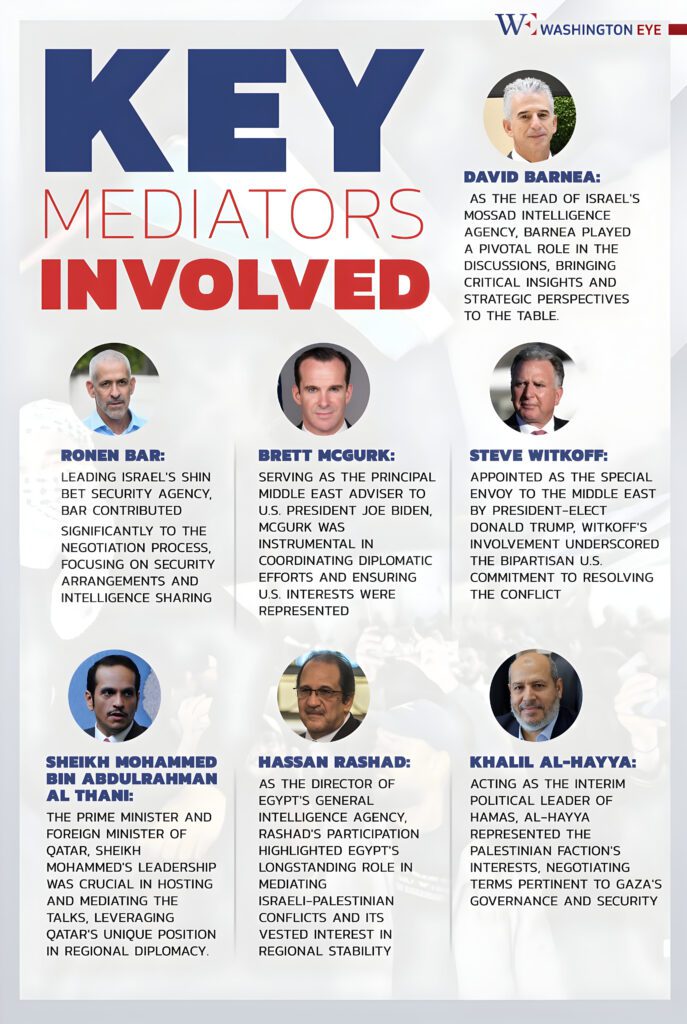After 15 months of relentless conflict in Gaza, a ceasefire agreement has been reached between Israel and Hamas, marking a significant step toward de-escalation. The deal is set to commence on Saturday, January 19, 2025, aiming to halt hostilities, provide humanitarian relief, and lay the groundwork for a more sustainable peace process.
The ceasefire agreement was facilitated by the concerted efforts of Qatar, the United States, and Egypt. Qatar hosted the talks in its capital, Doha, with Sheikh Mohammed bin Abdulrahman Al Thani, the country’s Prime Minister and Foreign Minister, playing a leading role in facilitating dialogue, given Qatar’s connections with Hamas. The United States provided diplomatic and strategic support through key figures such as Brett McGurk, President Biden’s principal Middle East adviser, and Steve Witkoff, President-elect Donald Trump’s special envoy to the Middle East. Egypt, a longstanding mediator in Israeli-Palestinian conflicts, contributed to the efforts through the leadership of Hassan Rashad, Director of Egypt’s General Intelligence Agency.
Terms of the Ceasefire
The agreement is structured into three distinct phases to ensure a gradual and strategic implementation. The first phase focuses on an immediate cessation of hostilities, which will last for an initial 42 days. During this period, Hamas has agreed to release 33 Israeli hostages, including women, children, and elderly individuals. In return, Israel will free hundreds of Palestinian prisoners. Alongside these measures, Israeli forces will retreat to a designated buffer zone within Gaza, a move designed to facilitate the return of displaced Palestinians to their homes. Humanitarian aid will also enter Gaza addressing the pressing needs of the civilian population who have suffered immensely throughout the conflict.
The second phase of the agreement seeks to build upon the initial efforts by addressing the more complex aspects of the conflict. Negotiations during this phase, set to begin on the 16th day of the ceasefire, aim to secure the release of all remaining hostages held by Hamas. In exchange, Israel is expected to finalize its military withdrawal from the Gaza Strip, thus ending its presence in the area. This phase is critical for fostering trust between the two sides and ensuring the ceasefire holds.
The third and final phase of the agreement shifts focus toward long-term stability and reconstruction. Efforts during this phase will be directed toward rebuilding Gaza’s devastated infrastructure, a process that is expected to span three to five years under international supervision. Simultaneously, discussions regarding the future governance of Gaza will take place, with the goal of establishing a framework for sustained peace and stability in the region. This phase is considered essential for addressing the root causes of the conflict and ensuring that similar hostilities do not arise in the future.
Continued Violence Undermines Peace Efforts
Despite the ceasefire announcement, violence has continued to erupt, casting doubt on the durability of the agreement. Within hours of the announcement, Israeli forces launched airstrikes in Gaza, resulting in at least 46 Palestinian fatalities. In response, militants in Gaza fired rockets into Israel, though no casualties were reported. The fragility of the situation highlights the challenges of implementing a ceasefire in a region marked by deep-seated animosities and mutual distrust.
Israeli Prime Minister Benjamin Netanyahu has expressed caution regarding the agreement, describing it as a “work in progress.” He pointed to unresolved issues, particularly concerning the terms of the prisoner exchange, as key sticking points. These uncertainties have fueled skepticism among observers and raised concerns about the ceasefire’s potential to achieve lasting peace.
Global Reactions
The international community has largely welcomed the ceasefire, viewing it as a necessary step toward stability in the region. Leaders and organizations, including the United Nations, have expressed hope that the agreement will pave the way for constructive dialogue and long-term solutions. However, the ongoing violence underscores the immense challenges involved in enforcing the ceasefire and ensuring adherence to its terms.
Echoes of Oslo in the Current Ceasefire
The recent ceasefire agreement between Israel and Hamas echoes the aspirations and challenges of the Oslo Accords, which were signed in the 1990s with the goal of establishing a framework for peace and a path toward a two-state solution. Both agreements were heralded as breakthroughs in their respective times, but they share a critical flaw: a lack of clarity on key issues, leaving substantial room for interpretation and disagreement.














